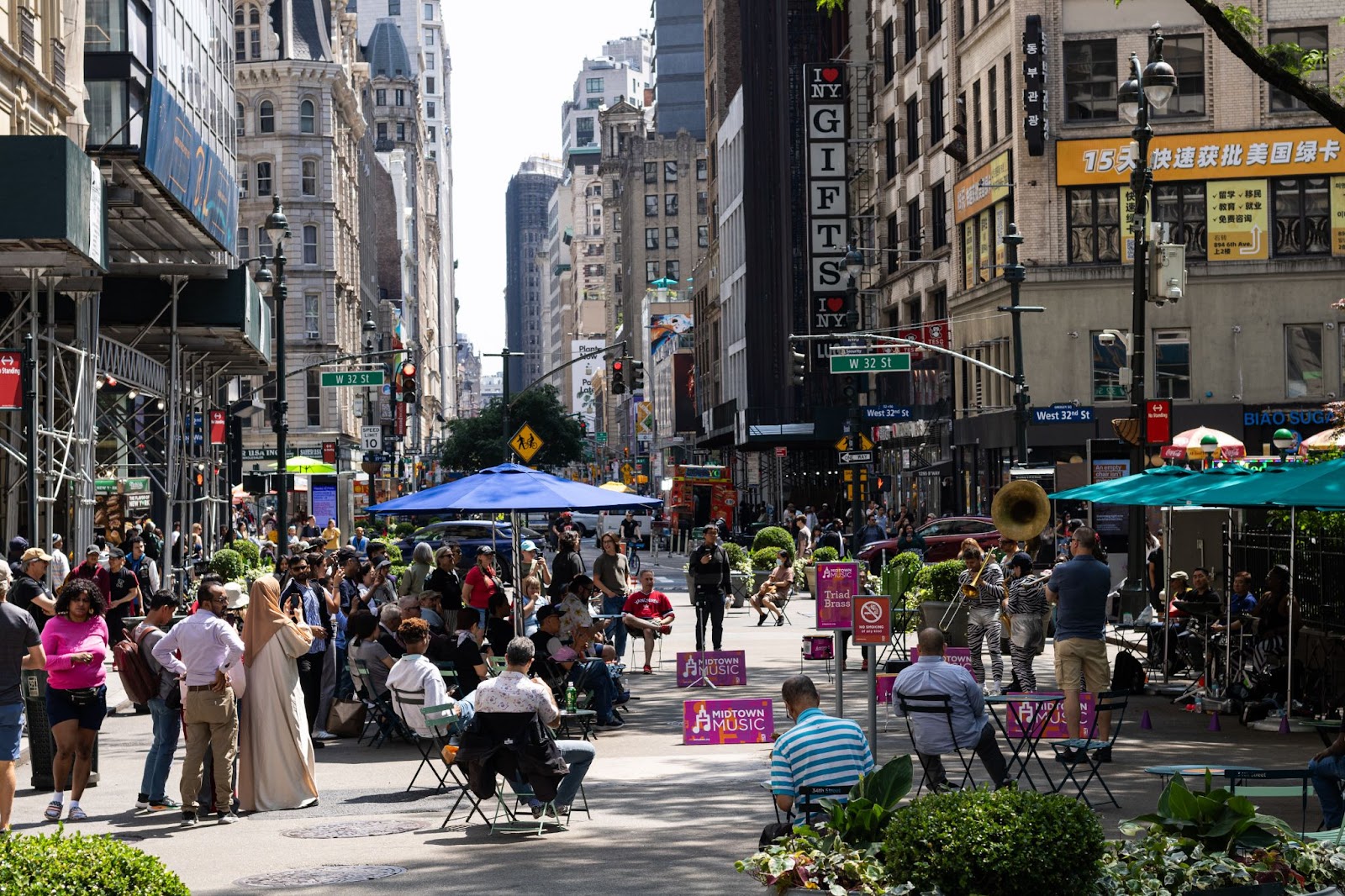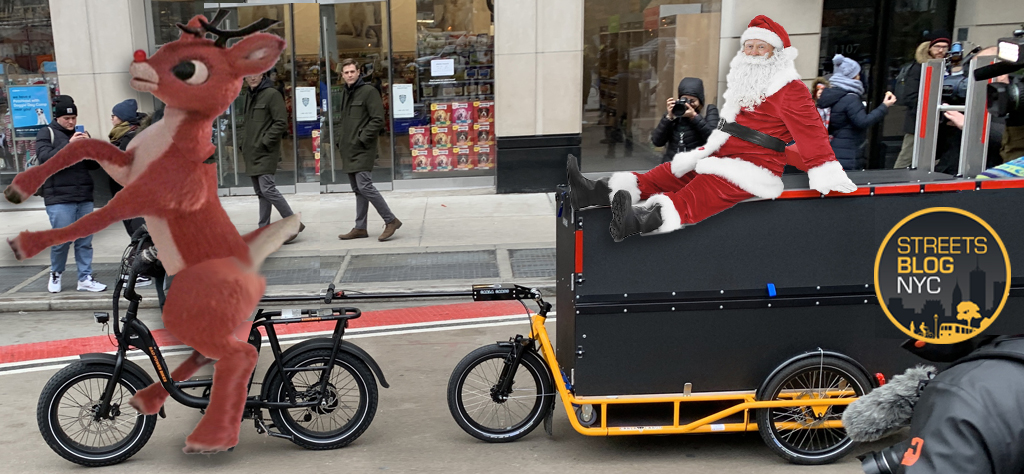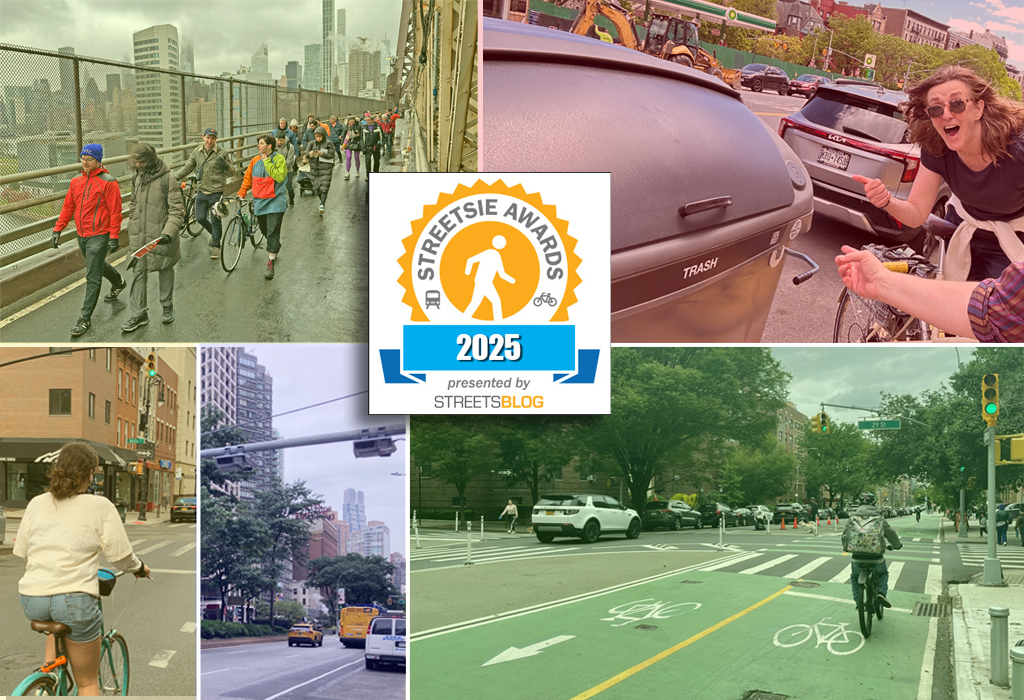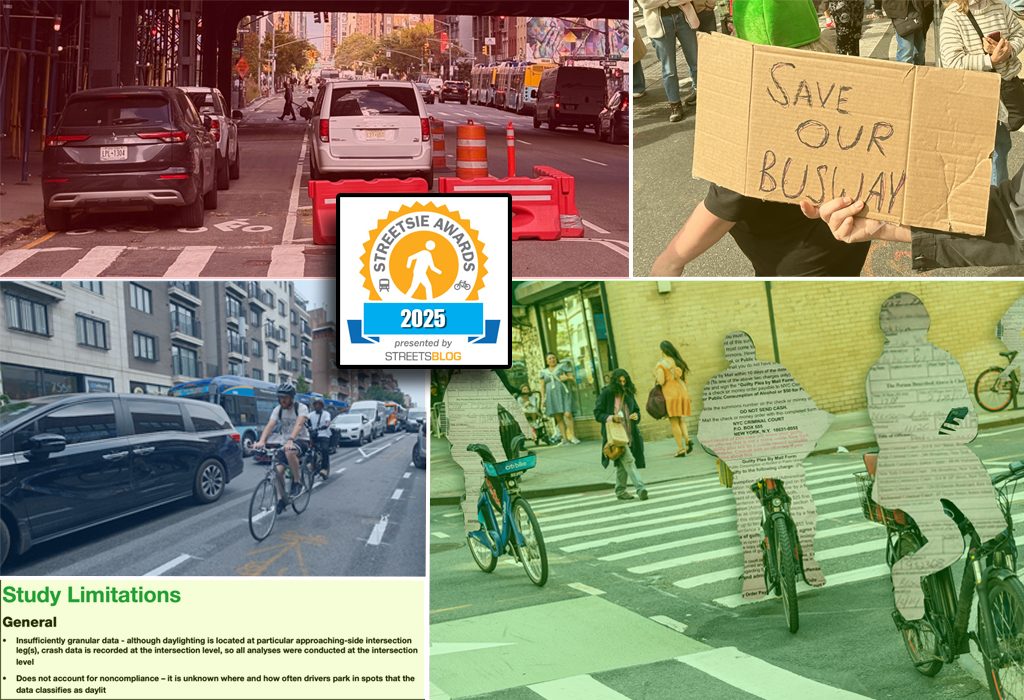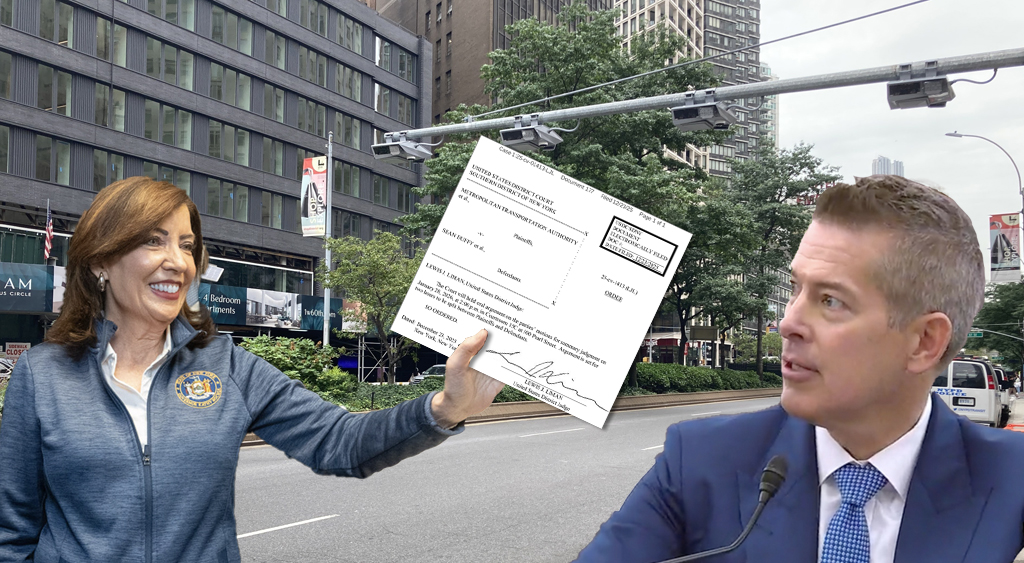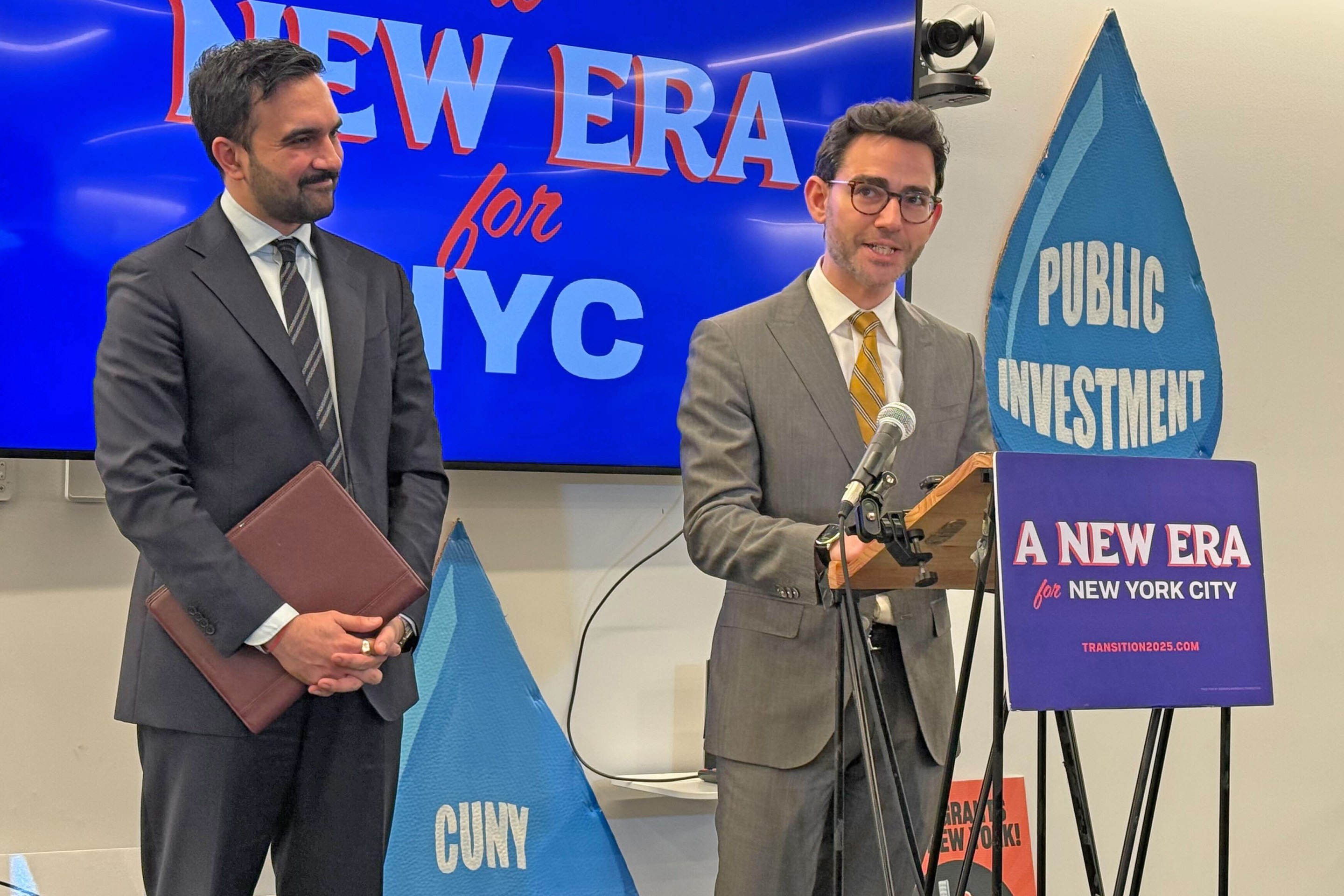New York City has the "vision thing" for the Great White Way.
The Department of Transportation is slowly turning Broadway into a "linear plaza" through the heart of Manhattan, transforming seven more Broadway blocks over the last two years from bleary car funnels into calmer streets with better sidewalks, bike lanes and outdoor dining areas.
DOT's "Broadway Vision" project, announced by Mayor Eric Adams in 2021, builds on strategic planning in the area by former Mayor Michael Bloomberg in 2009, when he shut off most car traffic from Times Square and Herald Square, and subsequent work by former Mayor Bill de Blasio to make Broadway a hub for pedestrians.
Safe streets advocates have long argued that the city should prioritize pedestrians and cyclists on Broadway, since the corridor is the only one that runs diagonal amid Midtown's grid pattern — making it somewhat of an odd-street-out, and nonessential for cars. Now complete with an almost continuous bike lane, miles of pedestrian space and one-way changes to slough off cars, the Manhattan stretch is marching toward advocates' vision of an urban park.
Streetsblog walked down Broadway in recent weeks to get a better idea of how the project has changed the street. Here’s what we saw — and what’s to come:
Union Square North
The blocks just north of Union Square between 17th Street and 19th Street got a facelift last year. DOT completely cordoned off car traffic from 17th to 18th, capitalizing on already low vehicle travel coming from Union Square. What used to be an underutilized street is now an extension of the Square, reserved for only cyclists and pedestrians.
Two-way lanes funnel bike traffic through the west side of the street while the remainder is left for pedestrian sprawl, as it has been for many years but with the addition of tables and umbrellas set up by the local Business Improvement District.
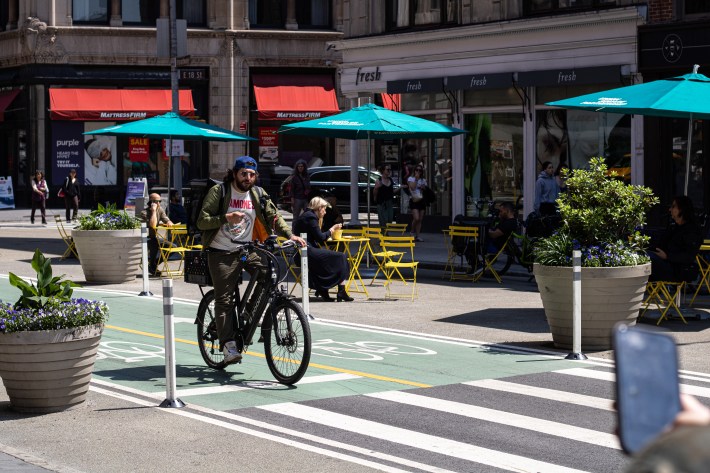
Streetsblog saw plenty of people taking advantage of the new space. One man, who gave the name Anthony, said he appreciated larger efforts to redesign bustling streets for New Yorkers.
“You don’t have to find a park anymore. You’ve got a place to have a quick lunch or a cup of coffee,” he said. "I love it."
After 19th Street, cyclists intermingle with sparse traffic — a feature of the project’s “shared street” design — until they reach the Flatiron Building and Madison Square and are forced to turn off Broadway toward Sixth Avenue before meeting back up with Broadway.
Listen. What’s so nice about the new stretch of #broadway #nyc near #unionsquare is the silence. It’s hard to believe this in nyc. Thanks @NYC_DOT pic.twitter.com/OMgXyJJdND
— Janet Liff (@JanetLiff) July 7, 2025
Flatiron District and NoMad
Lower Flatiron has remained largely unchanged since DOT upgraded it with shared streets in 2021 and dedicated plazas between 23rd and 25th all the way back in 2008.
New plazas — soon to be made permanent – sit between 25th and 27th Streets and give pedestrians more lounging space. Two-way bike lanes accomodate cyclists after the plazas for five more shared blocks.
With two-way bike lanes coming up from Union, the only legal way for cyclists to continue northbound into Flatiron requires them to turn east off Broadway and head up 5th Avenue. Streetsblog saw cyclists ignore pavement marks and head north on Broadway anyway, putting them at risk of colliding with incoming traffic.
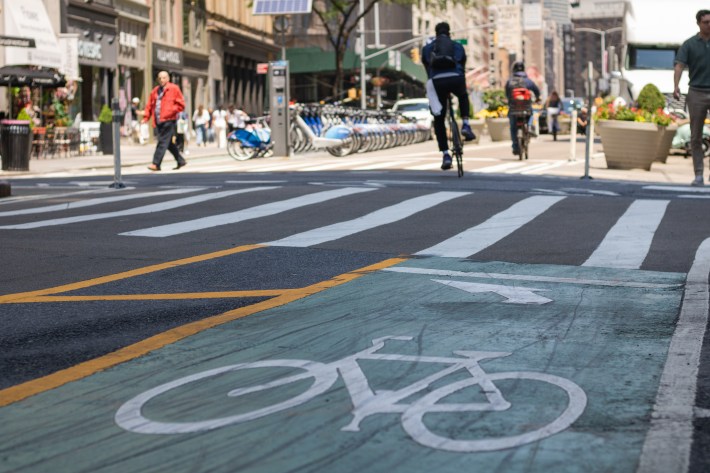
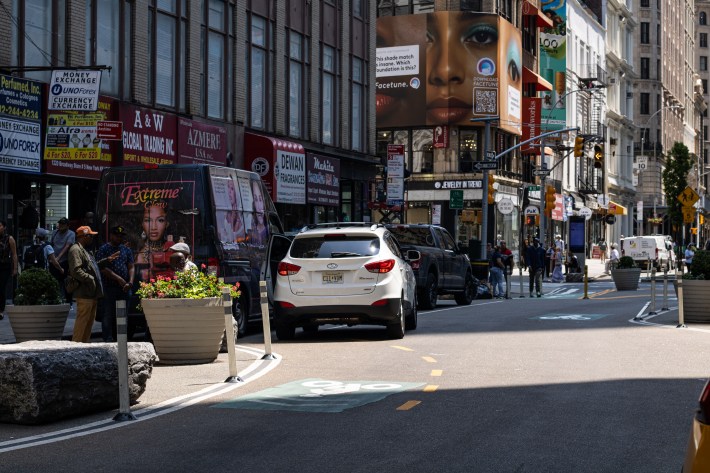
The good news is that streets between 21st Street and 27th Street will undergo capital redevelopment and a rethinking of the bike network sometime in the next few years, said Kurt Cavanaugh, the Flatiron NoMad Vice President of Planning, Streetscape & Capital Projects. In early 2023, Mayor Adams announced a $375-million citywide streetscape project that will build out plazas with more permanent materials, including on Broadway, but designs have yet to be finalized.
“We are fully aware of the challenges as you approach the 23rd intersection with people going both ways and not really having the infrastructure to support that,” he said. “We’re looking to work with the city on a solution as part of the capital reconstruction.”

Even still, Cavanaugh said that Flatiron District business owners and the BID’s staff were excited to have a “front row seat” to Broadway Vision’s ongoing successes. The area has seen both Citi Bike and subway ridership double in recent years, Cavanaugh noted.
“We see it as a model of people-first design. When you prioritize people over motor vehicles, you usually tend to invite a lot more foot traffic,” he said. “It’s overall been very much net positive — economically and culturally — in the district.”
Greeley Square, Herald Square
A sharp detour around Greeley Square at 32nd Street brings the continuous bike lane to a halt and throws cyclists across a busy intersection. This block continues to be a safety issue, creating 26 crashes and 35 total injuries since 2023, according to crashmapper.org.
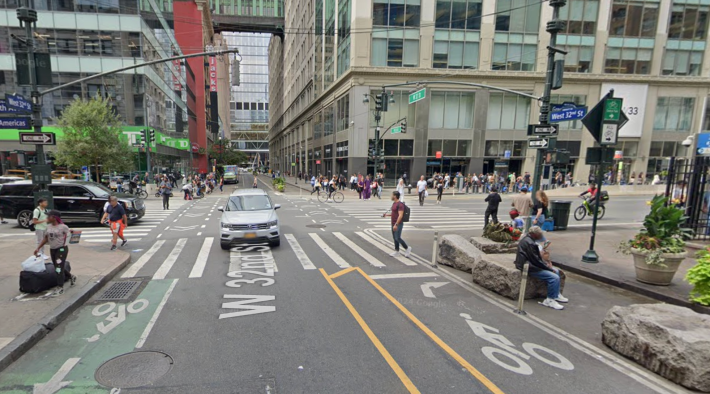
The city is planning permanent changes for the area, but gave no timeline for a redesign when Streetsblog asked via email. Preliminary designs for an updated 32nd Street have existed since 2023, but show the same dangerous unprotected detour going unaddressed.

Moving north up Broadway, DOT unveiled plans last month to tack another pedestrian-only block on to Herald Plaza and Herald Square Park between 35th and 36th Street. Right now, the area already rarely sees car traffic and simply serves as a holding space for Citi Bike, making the redesign a no-brainer.

A worker in an adjacent high-rise told Streetsblog he welcomed the changes, which DOT plans to complete this fall.
“For everyone who works here, there will be a lot of advantages,” said Maxime Laurent, who is also a frequent Citi Bike user. “It’s much nicer to commute by bike … I think it should be encouraged more by the city.”
Garment District
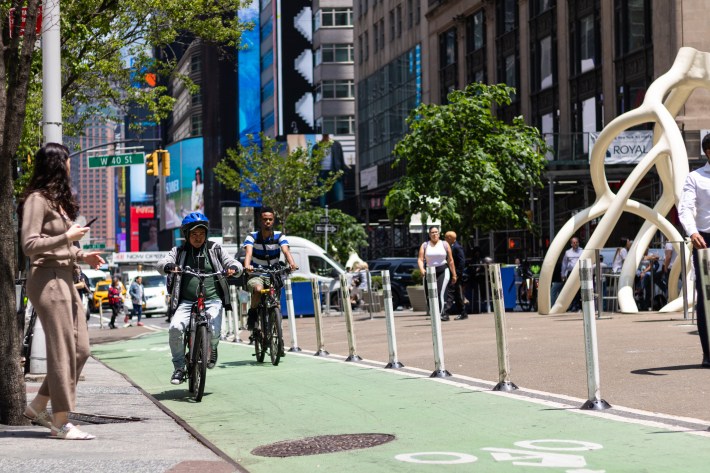
The Garment District between 34th Street and 42nd Street is set to see the most action in the next portion of Broadway Vision.
Next year, capital construction will permanently enhance the already pleasant paths and atmosphere for cyclists and pedestrians between 38th Street and 40th Street. The proposed design moves the two-way bike lane to the east and adds permanent patches of greenery.
Two blocks of shared streets complete with dual bike lanes will finish linking up the area’s separate plazas and create the “cohesive refresh” the DOT wants. Current plans cut down on existing parking along the corridor by about 90%, giving plenty of breathing room to cyclists.
The bisecting bike lane, however, doesn’t seem all that necessary when it comes at the expense of pedestrian space, said Anne Bonacum, director of planning & development for the Garment District Alliance, since there are bike lanes on adjacent streets. There are also typical concerns about security, Bonacum said, that come with opening up more urban space that are “tricky and costly to manage.”
Despite an added burden on BIDs to maintain new spaces, Bonacum said that the BID is generally supportive of the new changes coming to the area.
“We’re always in favor of more public space because we don’t really have much public space in the neighborhood,” she said. “Things that improve quality of life and pedestrian experience [are] important.”
Times Square
The DOT will reconfigure the street between 41st and 42nd into a shared block, providing a slightly more welcoming lead-up to Times Square. Despite that, the street will not formally allow northbound cycling traffic, which could create the same problem seen in Flatiron.
Going north, 47th to 50th Street are shared blocks that provide adequate space for walking and cycling, although Streetsblog saw little of either when visiting. Though successful at calming traffic, the redesign has seemingly fallen flat at attracting more foot traffic.
The DOT also seems to have forgotten about its earlier ambitions. In 2021, it laid out plans to update the three streets even further north, between 50th and 53rd, with an unspecified completion date. More than four years later, those streets — including multiple adjacent lanes of automobile traffic — remain unchanged.
A boon for business
According to nearby store workers, Broadway Vision has been a success for local businesses and helped create "economic resiliency" for the area, one of the city's goals for the project.
Foot traffic on Broadway has grown by over 40 percent in some areas over the last three years, according to the Flatiron NoMad Partnership, and storefront occupancy on the strip is higher than on surrounding streets. The DOT also says that bustling car traffic is down, marking main victories for the project.
Jon Check, vice president of operations at the Broadway restaurant Pura Vida Miami, said that the location draws people in and contributed toward “extraordinary” performance since the company moved in last year.
“We really just love being a part of a vibrant neighborhood that feels very welcoming to people walking, enjoying themselves, enjoying the plaza, enjoying our space,” Check said, adding that he sees more pedestrians on the street later into evenings.
At restaurant La Pecora Bianca, managers Jayson Zaffino and Carter Thompson said there’s been a noticeable uptick in business since the DOT installed a plaza outside their establishment. According to Zaffino, the restaurant gets almost triple the amount of walk-in customers as from reservations.
“It creates excitement for people who walk by. They want to be a part of a ‘New York moment,’” Thompson said. “It really boosts business.”
Paragon Sports, a family-owned sporting goods store on Broadway since 1908, is another beneficiary of Broadway Vision. On the new plaza block between 17th and 18th, pedestrians who used to keep walking now linger on the block and wander into the store, manager Tony Valme said.
Valme noted while he and other Paragon employees were initially hesitant about the project, they have since grown to appreciate the DOT-led reconfiguration — which has brought back an “old New York feel” to the area, he said.
The project overall? “A win,” said Valme.
A broader timeline of Broadway Vision:

